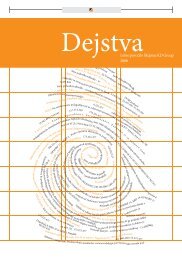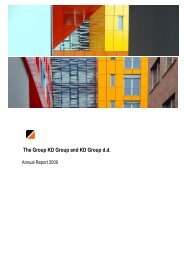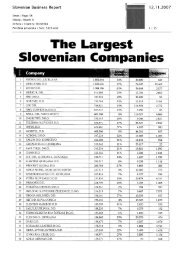We build business networks and relationships ... - skupina kd group
We build business networks and relationships ... - skupina kd group
We build business networks and relationships ... - skupina kd group
You also want an ePaper? Increase the reach of your titles
YUMPU automatically turns print PDFs into web optimized ePapers that Google loves.
KD Holding Group<br />
Notes to Consolidated Financial Statements as at <strong>and</strong> for the year ended 31 December 2007<br />
initial recognition of those assets, although the<br />
decrease cannot yet be identified with the individual<br />
financial assets in the Group, including:<br />
- adverse changes in the payment status of<br />
borrowers in the Group, or<br />
- national or local economic conditions that<br />
correlate with defaults on the assets in the Group.<br />
investment has a variable interest rate, the discount<br />
rate for measuring any impairment loss is the<br />
current effective interest rate determined under the<br />
contract. As a practical expedient, the Group may<br />
measure impairment on the basis of an instrument’s<br />
fair value using an observable market price. The<br />
calculation of the present value of the estimated<br />
future cash flows of a collateralised financial<br />
The Group first assesses whether objective evidence<br />
of impairment exists individually for financial<br />
assets that are individually significant. If the Group<br />
asset reflects the cash flows that may result from<br />
foreclosure less costs for obtaining <strong>and</strong> selling the<br />
collateral, whether or not foreclosure is probable.<br />
determines that no objective evidence of impairment<br />
exists for an individually assessed financial asset,<br />
whether significant or not, it includes the asset in<br />
a <strong>group</strong> of financial assets with similar credit risk<br />
characteristics <strong>and</strong> collectively assesses them for<br />
impairment. Assets that are individually assessed<br />
for impairment <strong>and</strong> for which an impairment loss is<br />
or continues to be recognised are not included in a<br />
collective assessment of impairment.<br />
If there is objective evidence that an impairment<br />
loss on loans <strong>and</strong> receivables or held-to-maturity<br />
investments carried at amortised cost has been<br />
incurred, the amount of the loss is measured as the<br />
difference between the asset’s carrying amount <strong>and</strong><br />
the present value of estimated future cash flows<br />
(excluding future credit losses that have not been<br />
incurred) discounted at the financial asset’s original<br />
effective interest rate. The carrying amount of the<br />
asset is reduced through the use of an allowance<br />
account <strong>and</strong> the amount of the loss is recognised in<br />
the income statement. If a loan or held-to-maturity<br />
For the purposes of a collective evaluation of<br />
impairment, financial assets are <strong>group</strong>ed on the basis of<br />
similar credit risk characteristics. Those characteristics<br />
are relevant to the estimation of future cash flows<br />
for <strong>group</strong>s of such assets by being indicative of the<br />
debtors’ ability to pay all amounts due according to the<br />
contractual terms of the assets being evaluated.<br />
Future cash flows in a <strong>group</strong> of financial assets that are<br />
collectively evaluated for impairment are estimated on the<br />
basis of the contractual cash flows of the assets in the<br />
Group <strong>and</strong> historical loss experience for assets with credit<br />
risk characteristics similar to those in the Group. Historical<br />
loss experience is adjusted on the basis of current<br />
observable data to reflect the effects of current conditions<br />
that did not affect the period on which the historical loss<br />
experience is based <strong>and</strong> to remove the effects of conditions<br />
in the historical period that do not exist currently.<br />
Estimates of changes in future cash flows for <strong>group</strong>s of<br />
assets should reflect <strong>and</strong> be directionally consistent with<br />
213







